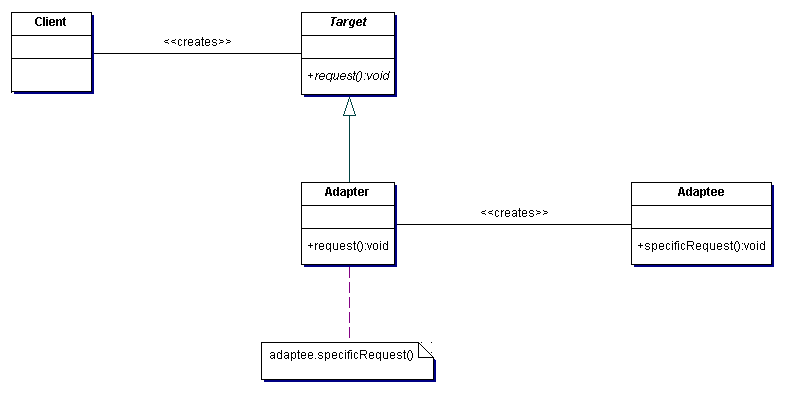Adapter
Intent
Convert the interface of a class into another interface clients
expect. Adapter lets classes work together that couldn't otherwise
because of incompatible interfaces.
Problem
An "off the shelf" component offers compelling functionality that you
would like reuse, but its "view of the world" is not compatible with
the philosophy and architecture of the system currently being
developed.
Discussion
Create an intermediary abstraction that translates, or maps, the old
component to the new system. Clients call methods on the Adapter
object which redirects them into calls to the legacy component. This
strategy can be implemented either with inheritance or with
aggregation.
Adapter functions as a wrapper or modifier of an existing class. It
provides a different or translated view of that class. It effectively
offers an impedence-matching facility.
Structure
It is using aggregation is its delegation mechanism. The inheritance shown is
only for interface - not for implementation.

Example
The Adapter pattern allows otherwise incompatible classes to work
together by converting the interface of one class into an interface
expected by the clients. Socket wrenches provide an example of the
Adapter. A socket attaches to a ratchet, provided that the size of the
drive is the same. Typical drive sizes in the United States are 1/2"
and 1/4". Obviously, a 1/2" drive ratchet will not fit into a 1/4"
drive socket unless an adapter is used. A 1/2" to 1/4" adapter has a
1/2" female connection to fit on the 1/2" drive ratchet, and a 1/4"
male connection to fit in the 1/4" drive socket. [Michael Duell,
"Non-software examples of software design patterns", Object
Magazine, Jul 97, p54]
Non-software example
Rules of thumb
Adapter makes things work after they're designed; Bridge makes them
work before they are. [GOF, p219]
Bridge is designed up-front to let the abstraction and the
implementation vary independently. Adapter is retrofitted to make
unrelated classes work together. [GOF, p161]
Adapter provides a different interface to its subject. Proxy provides
the same interface. Decorator provides an enhanced interface.
[GOF. p216]
Adapter is meant to change the interface of an existing object.
Decorator enhances another object without changing its interface.
Decorator is thus more transparent to the application than an adapter
is. As a consequence, Decorator supports recursive composition,
which isn't possible with pure Adapters. [GOF, 149]
Facade defines a new interface, whereas Adapter reuses an old
interface. Remember that Adapter makes two existing interfaces work
together as opposed to defining an entirely new one. [GOF, pp219]
C++ Demos | Java
Demos | Lab

